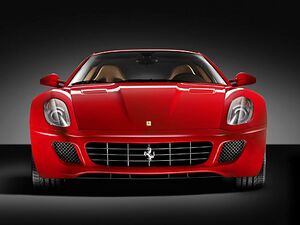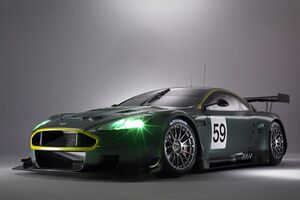HowTo:Tell the Difference between an American and a European car

|
HowTo This article is part of Uncyclopedia's HowTo series. See more HowTos |
In these increasingly globalised times, it's sometimes hard to see the real difference between two similar objects made in completely different countries. This is especially the case with cars: nowadays cars are produced all over the world, leaving people who try the find out about where the car came from clueless.
However, some differences will never disappear. This is essential in the biggest rivalry in cars of all time: that between American and European cars.
Looks[edit]
One of the most essential things about a car is the design: nothing says, "I know more about cars than you do" than getting the look of the car right. It's also the first thing that people tend to look at - the actual bodywork of the car. It can't just say something about the owner. No, most of the time, it also says something about the manufacturer of the car.
There is, however, one fact that's just staggering: when you break it down, it seems that a continent is a decisive factor for the design of the car, thus the necessity of making a difference between America and Europe. This comparison is fair, because the size of these two parts of the world is roughly the same.
The European looks[edit]
In Europe, the looks of a car are an important aspect. It seems that European cars makers are not satisfied until the car they've been working on looks fantastic. The best proof of this can only be shown:
As you can see, these two cars are just magnificent. The edges are where they're supposed to be, the color is perfect and the all-round design makes the cars look like they were created by nature herself. The car looks as if it was made by a God. Hell, this piece of text can barely stand the sheer perfection that these cars have. AAAAAAA, it hurts! And you can have this for only $1.5 million!
Now, you might think that that's little unfair, because those are the best models of the best companies, but let's take a look at the regular European car:
Now, even though this is a car that any German dumbass can buy, it's still has the looks of a champion: the roundings are perfect, exactly where they're supposed to be and the decent price makes it even more fantastic. "Sadly most of the parts fall off if you take any sort of dip in the road." is an opinion held by the Americans, who make this kind of stuff up to make up for their awful car industry.
I guess that's what European looks are all about: quality as a number one priority. Quality that sometimes doesn't come cheap, but at least it works. Not only that, you can look at it all day long and you'll still never get tired of it. You wonder how they do it. You wonder "Why is this thing so damn good? Not only that, but why does it also work like a charm?" tsk
And I guess that there's only one answer to that: the human desire to better things, circumstances and life altogether. That's what European design aims for: To look even better than the last masterpiece.
Performance[edit]
Performance is also an essential when it come to cars. I've come up with three areas to measure performance:
- Speed
- Handling
- Braking
It's two out of three, so there has to be a winner.
Speed[edit]
This one is a no-brainer. American roads have a small top speed, but American cars strain just to reach it, and when they do, black smoke pours out of the exhaust and bits of the engine fly down the road behind them; whereas European roads allow the cars to drive as fast as they want, though the only cars that actually do so are those that cost at least $100,000.
The explanation for this is simple: An American 5-liter V8 engine produces enough power to rip the skin off a rice pudding, but not more. A European 5-litre V8 can produce upward of 450 bhp without even being special. The fact that the Europeans spell "litre" correctly shows that their engineers understand engineering.
Handling[edit]
Aha, now let's take a random, 1/4 angle turn. Let's have both cars drive at the same speed and let's have them both not brake. Here's what will happen:
- The European car will turn around the corner with ease. Hell, it's looks more dangerous than it really is. The driver can drink a cup of coffee, whistle a song, maybe read a news paper: his car will never crash. The only thing that can get damaged is the road or the laws of physics.
- When a American car tries to turn around a bend, three things will happen:
1: Rear end starts shaking. 2: Car continues in a completely straight line. 3: Car completely fails to stop and buries itself in the nearest tree. Europe has to be a clear winner here.
Braking[edit]
Here's what happens to the two cars at 60 mph/100 kph that must brake suddenly for a duck crossing the road:
- The European car brakes really, really hard and stops at least half a mile before the duck. Perfection.
- The American car brakes. It stops smoothly, right in front of the duck, which has just died of a heart attack. The car does not burn out its brakes or eat up its tires. It luxuriously rocks on its suspension for several minutes. Then it explodes in an unrelated factory fault.
Size[edit]
American cars are basically large compared to European cars. Most American "economy" cars can hold six Renault Espaces in just the back seat alone. The big reason for this is because Americans have fat, wobbly families and the fact that Americans are a bunch of lardy bastards which as said before can fit in to a tin can, but also Americans enjoy the occasional fuck in a car. They also enjoy drive-by's and hunting terrorists and drive-by terrorist hunts. It is for this reason alone that the government has mandated that all new models starting in 2009 will be equipped with Big Mac tables, mounted machine guns and Kevlar plating.
European cars, in keeping with European sensibility and a desire not to look like the A team, usually weigh less than the average American citizen. Because the average American citizen weighs in excess of 1,000 lbs. This being Uncyclopedia, you know that you're getting the most reliable data.
Safety[edit]
American cars have no lack of things known as 'safety features' including the massive bulk of most American cars protecting them in crashes; they're bumpers have also been design to withstand vehicular collisions up to 5mph, to assist females (and drunks) whilst parking. However American cars do not require safety features. This is because Americans themselves have evolved into having large crumple zones (ie.their body fat).
Durability[edit]
Even the smallest American cars look like they can tear through most any European car, due to their ridiculous size. However, they're also made of the cheapest plastic you can buy, so they crumple up nicely. Fortunately though, the bulk of your average American will ensure that they have some safety.
Conclusion[edit]
Americans think they are lords of the road.
Americans think that Europeans are quite naive to generalize Americans.
Most American cars are crap compared with European cars. But that's okay, because European cars would not be as cool if more Americans owned them.
An American with a European car is much better than a European with an American car as the former shows he has taste, money and power. The latter is trying to hide being a gay pansy by saying he can handle the "raw" "power" of a 9 Ltr, V12, 11 BHP American car.
Or you can just get a Japanese bike and rip the ass off both, still have time to catch a movie, and hook up some sweet ladies who are generally far more impressed with a nice bike anyway.
See Also[edit]
- America Cars are at great value compared to European counterparts. They're fast, comfortable, tough, and if one ever fails it is affordable to fix. Plus American cars have the added value of being modified and improved. America builds the best muscle cars, and is competitive with European automakers as far as performance is concerned. The Corvette ZR1 is 200,000 dollars cheaper and available, while still beating most supercars built the same year. The Ford GT was a limited edition model that showed the exotic and performance aspect that captures the great ingenuity and taste that American Cars exhibit. The automatic gears ensure that driving them feels soggy and bovine
- Europe The European automakers make solid luxury cars that break down and cost a fortune to repair. Their supercars are some of the best because they refine the interior with an unlimited budget. The price of gas in Europe and the size of the roads has affected the shape and size of cars more so than the waist line of the consumer. It's not that Americans are overweight and need larger cars but, that European roads are narrow, overcrowded and always winding. Unlike the clear empty freeways of LA or the streets of New York.
- Car Say what you want about the comparison between European and American Cars. Japanese Car makers build luxury, economic, and performance orientated cars that push most of the car industry into the shadows. Toyota, Lexus, Nissan, Honda, and Subaru have demonstrated that reliability, luxury and performance can be achieved with consistency. Regardless of where cars are built they should be an extension of the consumer, not a symbol of money. American Cars give their owners a sense of pride like the Japanese counterparts, but luxury European cars are just cool until the next model comes out, except for Lambo's and Ferrari's which are in a class of their own and overall timeless cars.
- Britian The automobiles in The UK drive on the opposite side of the road which can cause of a lot of problems for tourists.




